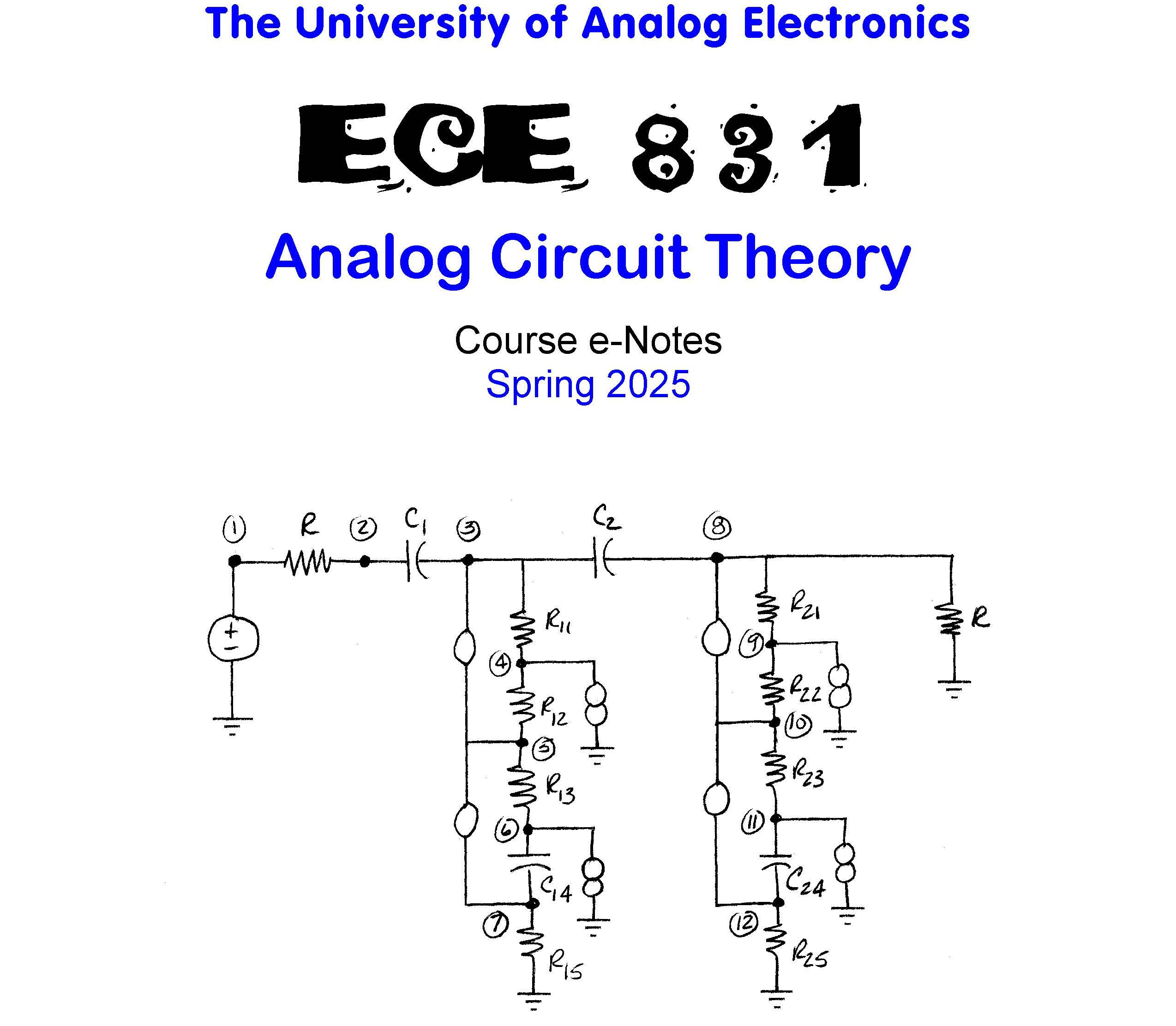Description
ECE 831: Analog Circuit Theory was a 3-credit course taught at Michigan State University for Electrical and Computer Engineering majors. The catalog description for this course is: Positive real functions. Filter approximations. Passive and active network synthesis. Nullor network analysis and synthesis. Active filters. Stability. Research Project. The prerequisite for this course is an undergraduate course in electric circuits.
The reference textbooks used in this course are :
W-K. Chen, Passive and Active Filters: Theory and Implementations, Wiley, 1986
L. T. Bruton, RC-Active Circuits Theory and Design, Prentice-Hall, 1980
Table of Contents
Chapter 1: Fundamentals of Passive Circuit Theory
A) Passive Network Nodal Analysis
Nodal Analysis Algorithm
B) Source Transformations
Pushing a Voltage Source Through a Node
C) Passive Network Mesh Analysis
Mesh Analysis Algorithm
D) Source Transformations (revisted)
Moving a Current Source Around a Loop
E) Duality
Inspection Transformation
F) Linearity and Superposition
Proof using Node Equations, Proportionality
G) Substitution Theorem
Voltage Substitution, Current Substitution
H) Two Ports
Y-parameters, Z-parameters, Conversion, Transfer Functions, Reciprocity
I) Interconnection of Two Ports
Series Combination, Parallel Combination
J) Scaling Network Functions
Magnitude Scaling, Frequency Scaling
K) Tellegen’s Theorem
Application to the Conservation of Power
Chapter 1: Supplemental Problems and Solutions
S1.1, S1.2, S1.3, S1.4, S1.5, S1.6, S1.7, S1.8, S1.9, S1.10
Chapter 2: Fundamentals of Active Circuit Theory
A) Nullator and Norators
Independent Sources, Norator, Short Circuit, Open Circuit, Nullator, Ideal Op-Amp, Ideal BJT
B) Nullator-Norator Nodal Analysis
Nodal Analysis Algorithm, Treble Tone Control, Simulated Impedance
C) Equivalence Relationships
Nullator Series Equivalence, Norator Series Equivalence, Nullator Parallel Equivalence, Norator Parallel Equivalence, Open Circuit Equivalence, Short Circuit Equivalence,
D) Controlled Source Models
VCCS, VCVS, CCCS, CCVS
E) Symbolic SPICE
Simulated Voltage Source, Simulated Inductance, Software
Chapter 2: Supplemental Problems and Solutions
S2.1, S2.2, S2.3
Chapter 3: Op-Amp Circuit Synthesis
A) Op-Amp Relocation
Pairing Property, Nullator Trees, Tree Generation Property, Relocation Theorem
B) Ground Relocation
Norator Trees, Indefinite Admittance Matrix, Singular Property, Characteristic Equations, Ground Relocation Theorem, Interchange Theorem
C) Transfer Function Synthesis
Source Insertion, Generating Active Filters
D) Gain-Bandwidth-Product Errors
fO – QO Errors, Error Approximation using Sspice, High Frequency Stability
E) Numeric Op-Amp Relocation Software
Case Study – Tow-Thomas Active Filter
Chapter 3: Supplemental Problems and Solutions
S3.1, S3.2, S3.3
Chapter 4: Passive Circuit Synthesis
A) LC One Port Synthesis
Even and Odd Polynomials in s, Imaginary Axis Roots, Partial Fraction Expansion form of Z(s), Reactance vs ω, First Foster Canonical Form, Duality, Second Foster Canonical Form, First Cauer Canonical Form, Continued Fraction Expansion, Second Cauer Canonical Form, Third Cauer Canonical Form
B) RC One Port Synthesis
LC – RC Transformation, Properties of RC Input Impedance, First and Second Foster Form Synthesis, First and Second Cauer Form Synthesis, Number of Elements, Internal Critical Frequencies, Third Cauer Form Synthesis
C) Two Port Synthesis by Ladder Development
Zeros of Transmission, LC Ladder Networks, Zero Shifting, Pole Removal
D) RC Ladder Two Port Synthesis
Zero Shifting, Case Study, Interpretation of Poles and Zeros
Chapter 4 Supplemental Problems and Solutions
S4.1, S4.2, S4.3, S4.4, S4.5, S4.6, S4.7
Chapter 5: Approximation Theory
A) Butterworth Low-Pass Approximation
Ideal Normalized Low-Pass Filter, Butterworth Approximation, Roots on a Unit Circle
B) Butterworth Filter Sections
Second Order Block, Normalized, Scaling, Third Order Block, Nth Order Block, Normalized Element Table
C) Butterworth High-Pass Approximation
Ideal Normalized High-Pass Filter, Low-Pass to High-Pass Transformation
D) Butterworth Band-Pass Approximation
Ideal Normalized Band-Pass Filter, Low-Pass and High-Pass Configuration
E) Butterworth Band-Stop Approximation
Ideal Normalized Notch Filter, Low-Pass and High-Pass Configuration
F) Chebyshev Low-Pass Approximation
Chebyshev Approximation,
G) Chebyshev Polynomials
Chebyshev Polynomials, Roots on an Ellipse
H) Normalized Chebyshev Low-Pass Table
Normalized Element Table for -1dB and-3dB Ripple
I) Design Example
Fifth Order Design
J) Bessel-Thomson Low-Pass Approximation
Delay Approximation,Bessel-Thomson Polynomials,
K) Normalized Bessel-Thomson Low-Pass Table
Normalized Element Table
L) Step Response
Approximating Delay Based on Bandwidth
M) Delay Scaling
N) Passive Butterworth Low-Pass Filters
O) Passive Butterworth High-Pass Filters
